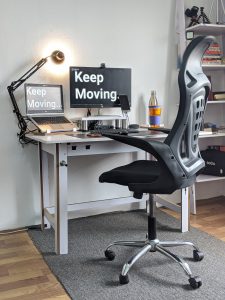Millions of people work jobs that require them to sit at a desk for many hours at a stretch, causing all sorts of back, neck, and spine problems, along with a host of other health-related issues. In fact, your whole body is affected by prolonged periods of sitting time including joints, blood circulation, metabolism rate, etc.
While the list is never-ending when discussing the ill effects of excessive sitting, if you work a 9-5 desk job, there are some very effective ways to ensure better spine health with a few minor adjustments to your workstation. Take a look at these tips to help you set up your desk and office chair keeping good ergonomics at the forefront of your workstation.
1. Adjust the Height of the Chair
When the chair is too high, your legs will either dangle or force you to sit forward, closer to the edge of the seat which takes a toll on your lower back. On the other hand, if the seat is too low, your knees will be bent more than they should be while your feet and ankles will bear more weight when planted on the ground.
Similarly, the manner in which you stand up from a seated position changes depending on the height of your office chair; the joints in your ankles, knees, and hips are strained more when the seat is low. The correct height at which your office chair should be adjusted must allow your hips and knees to be bent at a 90° angle with both feet comfortably resting flat on the ground.
2. Keep Your Upper Arms Parallel to the Sides of Your Body
It may seem insignificant but the angle at which your elbows are bent and how your upper arms are resting when working at a desk is very important. The height of the desk and your office chair must be synchronised so that your upper arms are parallel to your spine while your elbows are bent at a 90° angle with your hands and forearms resting on the desk in front of you.
The ill-effects of keeping your arms raised too high or too low (to the point where your shoulders drop) include putting an unnecessary strain on your shoulder blades, shoulder joints, and upper back. This, in turn, causes pain and tightness in these specific areas.
3. Choose a Chair With Adequate Back Support

While some people prefer to use a separate cushion while sitting down at their desk, there are numerous office chairs on the market that are ergonomically designed for desk jobs. Some of these come with inbuilt cushioning for lower and upper back support while others have adjustable bands that users can move up or down to provide optimal support.
Another important factor to consider is the level of reclination that the chair has. Typically, the backrest should be angled at 90°, or just slightly past it. If the chair leans back too much, it will encourage a forward head posture which can be detrimental to your cervical spine health over time.
4. Support Your Feet if Needed
Under some circumstances wherein your office chair is too high and therefore, your feet cannot rest flat on the ground, place a footstool under the desk to support your feet as needed. As we mentioned earlier, it is not ideal to allow your feet to dangle while in a seated position, nor is it advisable to support your feet and legs with just your toes touching the ground.
Resting your feet flat on a footstool (with your knees bent at a 90° angle) will reduce foot pain caused by excess stress placed on the feet when sitting for long hours on a high office chair.
5. Keep Your Screen at Eye-Level
Apart from excessive phone usage, staring at a computer or laptop screen all day can lead to forward head posture. If you don’t keep your posture in check while sitting and standing, you are guaranteed to experience a host of pain-related issues in your upper back and neck.
The importance of adjusting the screen in front of you so that it is at eye level is crucial for maintaining a healthy sitting posture while at your desk. There are many accessories on the market that allow you to elevate and adjust your laptop/screen, however, you must ensure that the keyboard is not raised to the point where your forearms require to be elevated as well (this is only acceptable if your elbows remain bent at a 90° angle while your forearms are resting on a flat surface).
6. Ensure the Correct Chair Depth

The depth of the chair you are sitting in can affect your spine by placing added stress on it. It can also cause back pain and reduce blood circulation in your legs (when the chair depth is too deep). If you are unsure of how to measure the depth of your office chair, sit down with your back upright, and rest against the backrest. Keep your knees bent at a 90° angle, and measure the space between your calves and the edge of the seat. Typically, there should be enough space to snuggly fit a fist in between; anything smaller than that means the seat depth is too deep which, in turn, will hinder blood circulation to your legs.
If your office chair can be adjusted to bring the backrest forward, be sure to measure the correct depth between your calves and the edge of the seat to avoid the negative impact the extra depth has on your spine and body.
Along with the tips above to improve the ergonomics of your workstation, we advise taking measures to ensure that your daily overall sitting time is limited. From taking breaks and walking around the office, to standing up and performing quick mobility drills, there are plenty of ways to take care of your spine even when you work a 9-5 desk job. At MSK Therapy, we are happy to advise patients on the best practices to improve spine health while offering a wide range of chiropractic care treatments and customised physical therapy programs to reverse the negative effects that poor ergonomics have had on your health and body.
